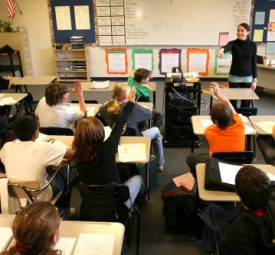
Summer is almost over and some educators, when thinking about the upcoming school year, may be considering “flipping their classroom” as a new method for instruction of essential skills.
A flipped classroom is one in which the background learning of a particular topic or skill occurs outside of class time - utilizing technological tools like videos and podcasts to teach the essential skills. This leaves class time free to work collaboratively on the higher-order thinking needed to utilize these skills.
In other words, class time is now free to spend working with the students because everyone has already received the background instruction that takes up so much time in the traditional classroom.
For example, let’s say you are teaching the Pythagorean theorem. This is how a “flipped” lesson about the theorem might go:
-
The students are instructed to watch the instructional video and then post one question about the theorem on your online classroom message board.
-
The question acts as both a record of participation and to guide the discussion in tomorrow’s class.
-
In tomorrow’s class, you already know who grasped the concept and who is still struggling, based on their questions.
-
Collaboratively, the class answers these questions, hopefully using some real-world examples.
Opponents of flipped instruction point to the widening “digital divide” and how our disadvantaged students might not have an opportunity to get on a computer and participate in the online components of the class. For those students, you may have to alter your expectations for turnaround time to allow for them to make it to the library or a computer lab. You may also want to modify your online components to be used on a cell phone. Many kids who do not have computers or internet at home have a phone that can meet the requirements of online coursework.
Opponents also worry that flipped classrooms are a precursor to a school where teachers are obsolete, replaced by computers and other technologies. If anything, the teacher is more important in a flipped classroom. Only a trained educator can differentiate the class time instruction that makes the method effective. Teachers frequently feel that their class time gets eaten by paperwork and other obligations. Flipped classrooms are a way of taking some of that time back, making you a more efficient teacher.
Scott Sterling is an education writer and commentator from St. Petersburg, FL. He spent five years teaching English/Language Arts in Title I middle and high schools.
For further reading:
Bill Tucker, The Flipped Classroom, EducationNext, Winter 2012, Vol. 12, No. 1
Ramsey Musallam, Should You Flip Your Classroom?, Edutopia, October 26, 2011
Alan November and Brian Mull, Flipped learning: A response to five common criticisms, eSchool News, March 26,2012.
Watch Salman Khan’s TED talk, Let’s Use Video to Reinvent Education
10 Big Benefits of Using iPads in Schools
Students who Struggle in the Mainstream: What their Homework Patterns May Tell You

